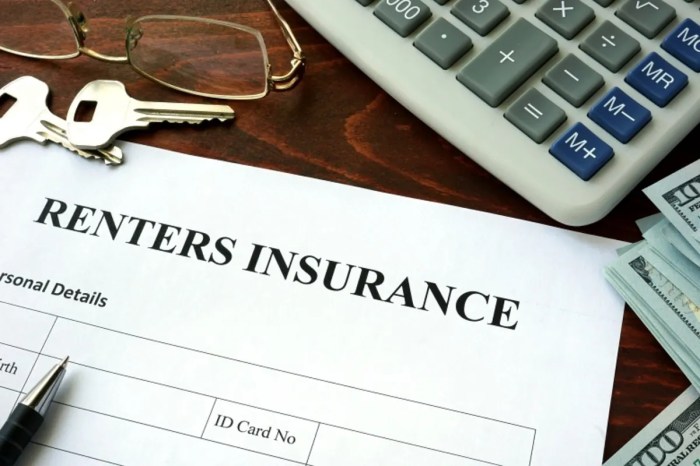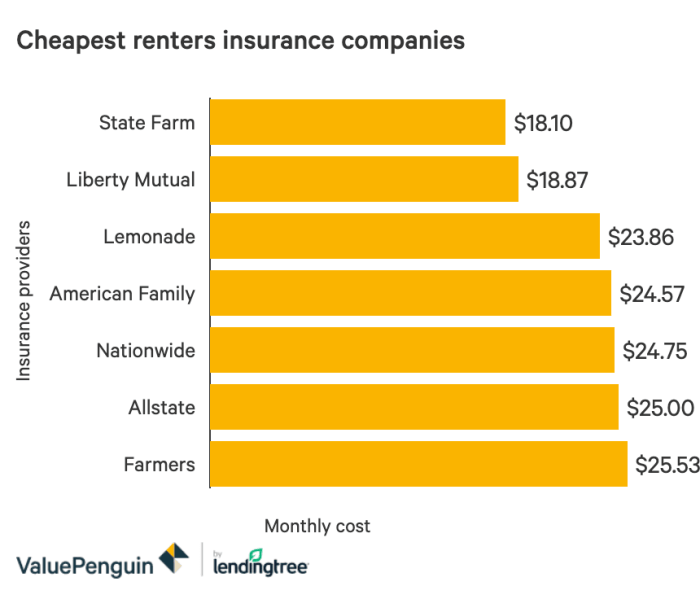Finding affordable renter’s insurance shouldn’t feel like navigating a maze. This guide demystifies the process, helping you understand the factors that influence cost and providing practical strategies to secure the cheapest policy without sacrificing essential coverage. We’ll explore various coverage options, compare insurers, and offer tips to significantly reduce your premiums. Ultimately, you’ll be empowered to make informed decisions and protect your belongings while staying within your budget.
From understanding the nuances of policy exclusions to leveraging smart strategies like bundling and increasing deductibles, we’ll equip you with the knowledge to find the perfect balance between affordability and comprehensive protection. This guide is designed to be your comprehensive resource, leading you through each step of the process, from obtaining quotes to filing a claim (should the need arise).
Defining “Cheapest Renter’s Insurance”

Finding the cheapest renter’s insurance involves understanding that “cheapest” doesn’t always mean “best.” The lowest premium might come with limited coverage, leaving you vulnerable in the event of a significant loss. Therefore, a balanced approach is crucial – securing adequate protection at the most affordable price.
Renter’s insurance costs are influenced by several key factors. These factors interact to determine the final premium you’ll pay. Understanding these elements empowers you to make informed decisions and find a policy that fits your budget and needs.
Factors Influencing Renter’s Insurance Cost
Several factors significantly influence the cost of renter’s insurance. These include your location (crime rates and natural disaster risk), the value of your belongings, your credit score, the amount of liability coverage you choose, and the deductible you select. For instance, someone living in a high-crime urban area will likely pay more than someone in a rural area with low crime rates. Similarly, a higher credit score can often result in lower premiums.
Coverage Variations and Their Impact on Price
Different coverage levels directly impact the cost of your renter’s insurance. A basic policy might offer only the minimum required coverage, resulting in a lower premium. However, adding optional coverages, such as increased liability limits or coverage for specific items like electronics or jewelry, will increase the cost. For example, a policy with $100,000 liability coverage will generally be more expensive than one with $50,000 liability coverage. Similarly, adding replacement cost coverage for personal belongings (rather than actual cash value) will increase the premium but provide better protection.
Comparison of Different Coverage Levels and Respective Costs
Let’s consider three hypothetical examples of coverage levels and their associated costs. These are illustrative and actual costs vary significantly based on the factors mentioned previously.
| Coverage Level | Liability Coverage | Personal Property Coverage | Estimated Monthly Premium |
|---|---|---|---|
| Basic | $100,000 | $10,000 | $15 |
| Standard | $300,000 | $25,000 | $25 |
| Comprehensive | $500,000 | $50,000 (with replacement cost) | $40 |
It is important to note that these are estimates. Actual premiums will vary depending on the insurer, location, and individual circumstances.
Typical Components of a Basic Renter’s Insurance Policy
A basic renter’s insurance policy typically includes several key components. These components provide essential protection against common risks. Understanding these components helps you assess whether a policy adequately meets your needs.
A standard policy generally covers personal property loss or damage from covered perils (such as fire, theft, or vandalism), personal liability protection (covering injuries or damages to others), and additional living expenses if your dwelling becomes uninhabitable due to a covered event. It’s crucial to carefully review the policy’s specific terms and conditions to fully understand the extent of coverage.
Finding Affordable Renter’s Insurance Options

Securing affordable renter’s insurance is crucial for protecting your belongings and providing financial security in unforeseen circumstances. Finding the right balance between cost and comprehensive coverage requires careful research and understanding of your needs. This section will guide you through the process of identifying and obtaining the most suitable and cost-effective renter’s insurance policy.
Comparison of Renter’s Insurance Providers
Choosing the right insurer can significantly impact your premium. The following table compares three hypothetical providers, highlighting key aspects to consider when making your decision. Remember that actual prices and coverage details vary based on location, coverage amounts, and individual circumstances.
| Insurer | Average Monthly Premium (Estimate) | Coverage Highlights | Customer Review Summary |
|---|---|---|---|
| Insurer A | $15 | $10,000 personal property coverage, $100,000 liability coverage, standard additional living expenses | Generally positive, known for quick claims processing. |
| Insurer B | $20 | $20,000 personal property coverage, $300,000 liability coverage, optional flood and earthquake coverage | Mixed reviews; some praise the comprehensive coverage, others cite slow claims handling. |
| Insurer C | $12 | $5,000 personal property coverage, $50,000 liability coverage, basic additional living expenses | Mostly positive for affordability, but coverage is considered less comprehensive. |
Strategies for Lowering Renter’s Insurance Premiums
Several proactive steps can help renters reduce their insurance costs without sacrificing essential coverage.
Implementing these strategies can lead to significant savings over the life of your policy. For example, increasing your deductible from $500 to $1000 could lower your premium by 10-20%, depending on the insurer and your location. Similarly, bundling insurance policies can offer substantial discounts.
- Increase your deductible: A higher deductible means you pay more out-of-pocket in the event of a claim, but it also reduces your premium.
- Bundle with other insurance: Many insurers offer discounts when you bundle renter’s insurance with auto or homeowner’s insurance.
- Improve your home security: Installing security systems or smoke detectors can sometimes qualify you for discounts.
Benefits of Bundling Renter’s Insurance
Bundling your renter’s insurance with other insurance policies, such as auto insurance, often results in significant cost savings. Insurers frequently offer discounts for bundling policies, rewarding customers for their loyalty and simplifying the management of their insurance needs. This is because managing multiple policies under one insurer reduces administrative costs for the company, allowing them to pass on savings to the customer. The convenience of managing all your insurance through a single provider is also a substantial benefit.
Obtaining Quotes from Multiple Insurance Providers
A step-by-step guide to obtaining multiple quotes for the best possible rate.
- Identify your needs: Determine the level of coverage you require for your personal belongings and liability.
- Gather necessary information: Collect details about your apartment, possessions, and any existing security measures.
- Use online comparison tools: Many websites allow you to compare quotes from multiple insurers simultaneously.
- Contact insurers directly: Reach out to insurers that interest you to discuss specific policy details and obtain personalized quotes.
- Compare quotes carefully: Review the coverage details and premiums before making a decision.
Impact of Location and Lifestyle on Premiums
The cost of renter’s insurance isn’t a fixed amount; it’s significantly influenced by your location and lifestyle choices. Factors like the likelihood of natural disasters, crime rates, and the value of your belongings all play a role in determining your premium. Understanding these factors can help you find the most cost-effective coverage.
Geographical location is a primary driver of renter’s insurance premiums. Insurance companies assess risk based on historical data for specific areas. Areas prone to hurricanes, earthquakes, wildfires, or high crime rates will generally command higher premiums due to the increased likelihood of claims. For example, a renter in hurricane-prone Florida will likely pay more than a renter in a less disaster-prone state like Iowa, even if all other factors are equal. Similarly, a renter living in a high-crime neighborhood might face higher premiums because of the elevated risk of theft or vandalism.
Geographical Location’s Influence on Premiums
Insurance companies use sophisticated actuarial models to analyze historical claims data for specific zip codes and geographic regions. This data helps them assess the probability of various types of losses, such as fire damage, theft, or liability claims. Areas with a history of high claims frequency will typically have higher premiums than areas with lower claim rates. This is a fundamental principle of insurance – riskier locations lead to higher costs. For instance, coastal areas susceptible to flooding will reflect this increased risk in higher premiums compared to inland locations.
Lifestyle Choices Affecting Premiums
Your lifestyle significantly influences the cost of your renter’s insurance. Owning valuable possessions, such as expensive electronics, jewelry, or musical instruments, increases your potential losses and, consequently, your premiums. The more valuable your belongings, the higher the coverage amount needed and, therefore, the higher the premium. For instance, a renter with a large collection of rare comic books will likely pay more than a renter with only basic furniture. Similarly, engaging in high-risk activities, like owning a large, aggressive dog breed, might increase your premiums due to the potential for liability claims.
Claims History and Future Rates
Filing a claim can impact your future insurance rates. While it’s essential to utilize your insurance coverage when needed, each claim is considered by insurance companies when assessing risk. Multiple claims, especially for significant amounts, can signal higher risk and lead to increased premiums in the future. Conversely, a clean claims history – no claims filed – can often result in lower premiums over time, as you demonstrate a lower risk profile to the insurer. Insurance companies view claims history as a strong indicator of future behavior.
The Claim Filing Process and Premium Impact
Filing a renter’s insurance claim involves reporting the incident to your insurer as soon as possible. You will typically need to provide detailed information about the loss, including documentation such as police reports (for theft) or photos of the damage. The insurer will then investigate the claim to verify the details and determine the extent of the coverage. After the investigation, they will determine the payout amount. The impact on your future premiums depends on the frequency and severity of your claims. A single, small claim might have little impact, but multiple claims or a large, expensive claim could lead to premium increases.
Closure

Securing the cheapest renter’s insurance is a balancing act between cost and coverage. By understanding the factors influencing premiums, comparing different insurers, and employing the strategies Artikeld in this guide, you can find a policy that offers adequate protection without breaking the bank. Remember, a little research and proactive planning can save you significant money in the long run, providing peace of mind knowing your belongings are protected.
Common Queries
What is the minimum coverage I need for renter’s insurance?
The minimum coverage depends on your individual needs and the value of your possessions. However, it’s generally recommended to have enough coverage to replace your belongings in case of loss or damage. Liability coverage is also crucial to protect you from lawsuits.
Can I get renter’s insurance if I have a poor credit history?
Yes, but your credit history may affect your premium. Some insurers may offer policies to those with poor credit, but you might pay a higher rate. Shopping around and comparing quotes is crucial.
What happens if I file a claim? Will my premiums increase?
Filing a claim can affect your future premiums, but not always. The impact depends on factors like the frequency of claims and the type of claim. Insurers consider your claims history when calculating future premiums.
How often should I review my renter’s insurance policy?
It’s recommended to review your policy annually, or whenever there’s a significant change in your life, such as acquiring valuable possessions or moving to a new location. This ensures your coverage remains adequate.